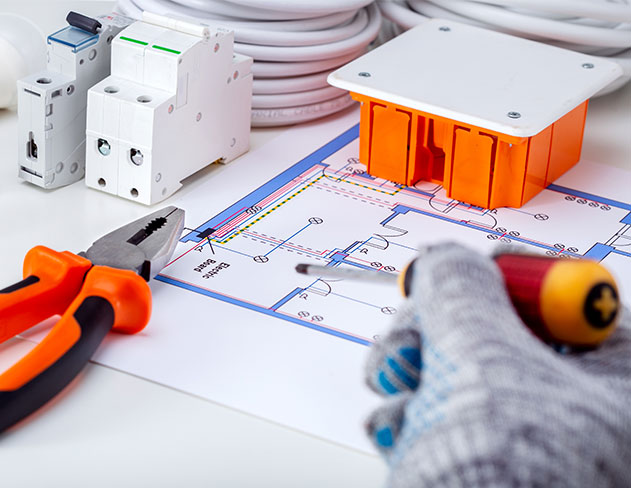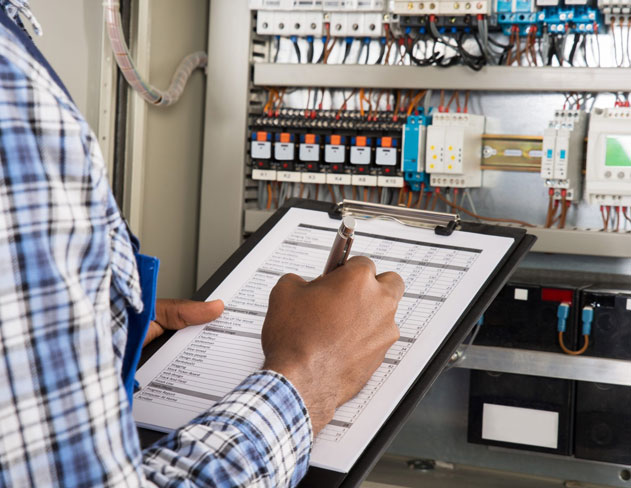We use electricity every day, from the moment we boil the kettle for our morning tea to the time we turn off our bedroom lights before we go to bed. Because we’re surrounded by electricity it can be difficult to remember that electricity can be dangerous – even fatal.
In this guide, we explore some of the common electrical hazards at home and how you can prevent an accident.
Why can electricity be a fire hazard?
You might not consider electricity to be a fire hazard, however over 28,000 electrical fires are reported in the UK each year. When electrical items overload, they get hot, and this build-up of heat can lead to a fire. Also damaged or poorly installed electrical systems have a risk of arcing which can also cause a fire.
What are some of the most common electrical hazards in the home?
Outdated or Faulty Wiring
Faulty wiring is a common electrical hazard at home and one of the main causes of fire or tripped circuits. It is recommended to have a Domestic EICR every 5 years to check the wiring in your home and make sure there are no faults on your electrical circuits.
The Domestic EICR will assess all the fixed electrical installation in your home including the wiring, sockets and switches, lights, and consumer unit. It is important to make sure all parts of the electrical installation are of Satisfactory status to be sure your installation is safe.
Mixing water and electricity
The most dangerous places in the home are those where you will find electricity and water together, like in the bathroom, kitchen, or garden. In the UK, it is not permitted to have plug sockets within 3 metres of the bath or shower due to the danger of water and electricity mixing. The bath or shower room is an electrical special location and enhanced safety practices must be used in these areas as stipulated in BS7671.
Wrong wattage light bulbs
This might surprise you but a light bulb with a higher wattage than the rating of the lamp holder can overheat and cause fire. Therefore, it’s always important to use the correct wattage light bulb for all your ceiling and floor lamps.
If you need a brighter light, you can either purchase an LED bulb – these tend to be brighter and cheaper to run than traditional halogen or incandescent lamps- or you can buy a new light fitting with a higher wattage rating.
We recommend against positioning lamps in areas where they touch materials such as upholstery, which could easily catch fire. Whenever you change your light bulbs, you should always unplug the lamp or switch it off at the wall to minimise risk.
Overloaded plug sockets
Plug sockets are designed to only handle a certain amount of electricity, so combining multiple extension leads and appliances into one socket can cause the socket to overload. This can cause overheating and burning, and consequently fire.
If you must use a multi-way extension lead, then you should make sure it includes a circuit breaker within the device. If the multi-way extension lead becomes overloaded or too hot, the breaker will trip, isolating the extension lead.
Dangers of overloading sockets
The main dangers of overloading sockets arise when too many appliances are linked together or the sockets are not well maintained. Taking the necessary precautions to avoid overloading sockets is crucial to avoiding potentially life-threatening housefires.
Dangerous appliances
There are some warning signs that your appliances may be damaged or faulty and not suitable for use. For example, is your hair dryer suddenly overheating? Or maybe your toaster is sparking when you use it? This could be a sign that there’s something wrong with the appliance. Do not ignore these signs, you could be risking a house fire if you continue using these appliances.
We recommend that you regularly check the safety of your appliances but certainly as soon as you notice that an electrical appliance isn’t working as it should. Our PAT Testing service is ideal in this situation, we will visit and check the safety of your appliances and advise of any next steps to be taken. Our PAT testing service will also identify any unsees or not obvious issues with your electrical appliances.
We also recommend not placing power leads near any electrical appliance that emits heat, as this could cause a fire.
Using reconditioned or second-hand electrical appliances
It is very tempting to buy second-hand electrical appliances as they are usually cheaper than the brand-new option. However, this may not be the best idea. A reconditioned or second-hand electrical appliance will not come with a manufacturer’s guarantee and could pose a serious risk of fire or electrical shock if it is faulty.
If you do decide to purchase second hand then the appliance should be PAT tested to check its electrical safety.
Incorrect use of extension leads
Extension leads are brilliant for providing temporary power to places around the home that are far away from a plug socket. However, make sure that you follow our recommendations for extension lead usage to reduce your electrical risk.
Extension leads should only be used as a temporary measure unless they have a suitably sized circuit breaker within to prevent overloading.
Remember that the extension lead cable is live at 230 volts and that if it were to be accidentally cut or trapped in a door, then there is a serious risk of life-threatening electrocution.
If you find that you’re constantly using extension cords around your home, then you should consider having additional hard-wired sockets installed.
How can I prevent electrical accidents in the home?
The best way to prevent electrical hazards in the home is to have your home’s electrical wiring and appliances electrically tested. At Hexo, we offer domestic EICRs at competitive prices to check your fixed electrical installation. We also offer PAT Testing for your appliances.
We will make sure that your home’s electrics are safe, and if we find any issues, we offer an automatic quotation for remedial work. Or if you’re worried about any of these electrical hazards at home, get in touch today.

